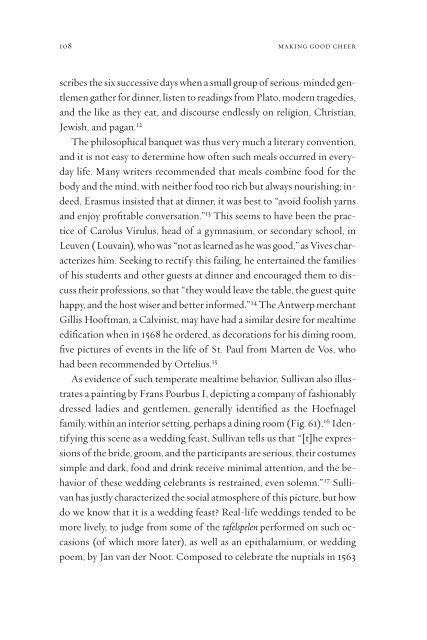Pieter Bruegel and the Art of Laughter - AAAARG.ORG
Pieter Bruegel and the Art of Laughter - AAAARG.ORG
Pieter Bruegel and the Art of Laughter - AAAARG.ORG
You also want an ePaper? Increase the reach of your titles
YUMPU automatically turns print PDFs into web optimized ePapers that Google loves.
108 making good cheer<br />
scribes <strong>the</strong> six successive days when a small group <strong>of</strong> serious-minded gentlemen<br />
ga<strong>the</strong>r for dinner, listen to readings from Plato, modern tragedies,<br />
<strong>and</strong> <strong>the</strong> like as <strong>the</strong>y eat, <strong>and</strong> discourse endlessly on religion, Christian,<br />
Jewish, <strong>and</strong> pagan. 12<br />
The philosophical banquet was thus very much a literary convention,<br />
<strong>and</strong> it is not easy to determine how <strong>of</strong>ten such meals occurred in everyday<br />
life. Many writers recommended that meals combine food for <strong>the</strong><br />
body <strong>and</strong> <strong>the</strong> mind, with nei<strong>the</strong>r food too rich but always nourishing; indeed,<br />
Erasmus insisted that at dinner, it was best to “avoid foolish yarns<br />
<strong>and</strong> enjoy pr<strong>of</strong>itable conversation.” 13 This seems to have been <strong>the</strong> practice<br />
<strong>of</strong> Carolus Virulus, head <strong>of</strong> a gymnasium, or secondary school, in<br />
Leuven ( Louvain), who was “not as learned as he was good,” as Vives characterizes<br />
him. Seeking to rectify this failing, he entertained <strong>the</strong> families<br />
<strong>of</strong> his students <strong>and</strong> o<strong>the</strong>r guests at dinner <strong>and</strong> encouraged <strong>the</strong>m to discuss<br />
<strong>the</strong>ir pr<strong>of</strong>essions, so that “<strong>the</strong>y would leave <strong>the</strong> table, <strong>the</strong> guest quite<br />
happy, <strong>and</strong> <strong>the</strong> host wiser <strong>and</strong> better informed.” 14 The Antwerp merchant<br />
Gillis Ho<strong>of</strong>tman, a Calvinist, may have had a similar desire for mealtime<br />
edification when in 1568 he ordered, as decorations for his dining room,<br />
five pictures <strong>of</strong> events in <strong>the</strong> life <strong>of</strong> St. Paul from Marten de Vos, who<br />
had been recommended by Ortelius. 15<br />
As evidence <strong>of</strong> such temperate mealtime behavior, Sullivan also illustrates<br />
a painting by Frans Pourbus I, depicting a company <strong>of</strong> fashionably<br />
dressed ladies <strong>and</strong> gentlemen, generally identified as <strong>the</strong> Hoefnagel<br />
family, within an interior setting, perhaps a dining room (Fig. 61). 16 Identifying<br />
this scene as a wedding feast, Sullivan tells us that “[t]he expressions<br />
<strong>of</strong> <strong>the</strong> bride, groom, <strong>and</strong> <strong>the</strong> participants are serious, <strong>the</strong>ir costumes<br />
simple <strong>and</strong> dark, food <strong>and</strong> drink receive minimal attention, <strong>and</strong> <strong>the</strong> behavior<br />
<strong>of</strong> <strong>the</strong>se wedding celebrants is restrained, even solemn.” 17 Sullivan<br />
has justly characterized <strong>the</strong> social atmosphere <strong>of</strong> this picture, but how<br />
do we know that it is a wedding feast? Real-life weddings tended to be<br />
more lively, to judge from some <strong>of</strong> <strong>the</strong> tafelspelen performed on such occasions<br />
(<strong>of</strong> which more later), as well as an epithalamium, or wedding<br />
poem, by Jan van der Noot. Composed to celebrate <strong>the</strong> nuptials in 1563












